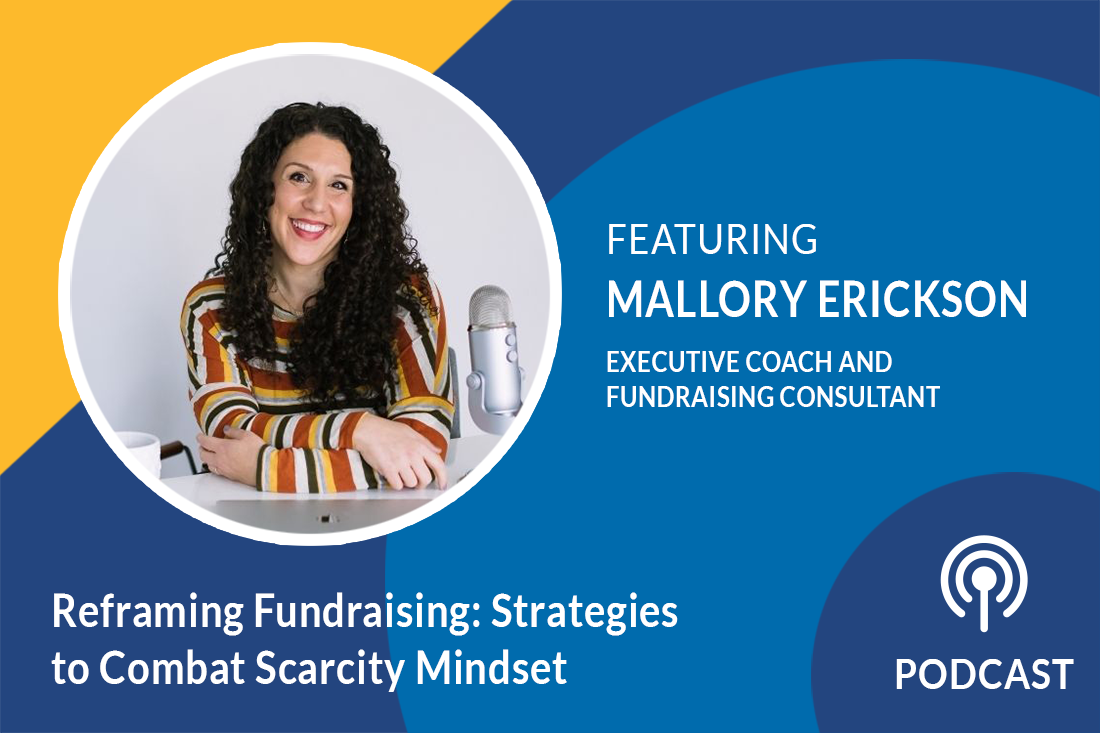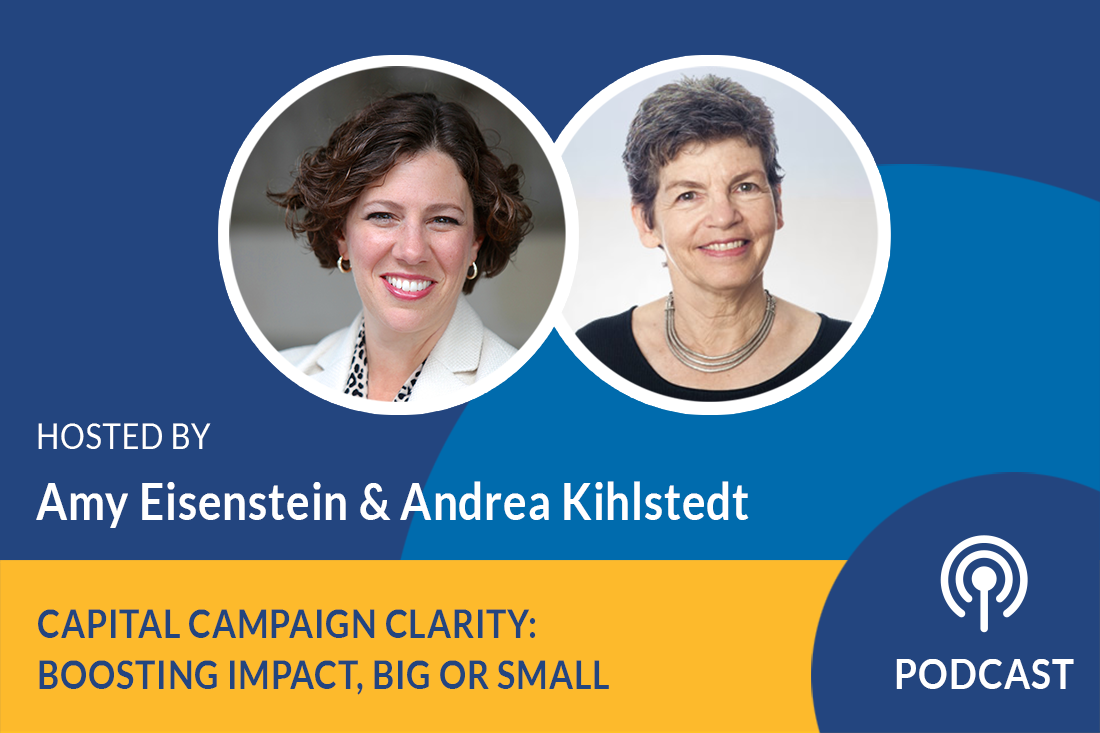Podcast: Asking for a Capital Gift, an Annual Gift and a Planned Gift in One Meeting

Season 4, Episode 19
In this episode, campaign experts Amy Eisenstein and Andrea Kihlstedt have some fun role-playing examples of asking donors for complex gifts that combine campaign, annual and planned giving.
This is an encore presentation originally aired on June 27, 2022.
Listen Now:
Amy Eisenstein:
We are really excited to be talking about how to ask for more than one gift at a time. And it will come as no surprise to you that the three gifts that we’re talking about are a capital campaign gift, an annual fund gift and a planned gift. So that’s what we’re going to cover in the next few minutes here with you.
We really want to think about how to be strategic and thoughtful when you’re asking for a gift, and always if possible, ask for more than one gift at once. Andrea, how do you think about asking for more than one gift at a time?
Seek Permission to Ask for Multiple Gifts First
Andrea Kihlstedt:
So Amy, because I knew we were going to cover this topic and I really sat myself down to think about how I feel about being asked for more than one gift at a time. It’s always helpful to think from your own perspective as a donor, it gives you a little window. Not that every donor thinks the way you do or the way I do. Everybody is a little different, but that’s at least a starting place into that. And it strikes me that there are some organizations that I feel strongly about and have a deep, long relationship with that I don’t mind. I wouldn’t mind if they ask me for multiple gifts at a time. But for an organization I don’t know well where I don’t have a relationship with them, for someone to come on early in the relationship and ask me for three gifts at once, for me wouldn’t work.
So I just want to say that our point, I think, and maybe you disagree Amy, but the point that I would want to make is that you have to look carefully at the relationship you and your organization have with the donor you’re talking to, and consider whether a multiple ask is appropriate for that donor at that time. And it may be, or it may not be. That’s point number one. We have point number two, and then I’m going to turn it back to you, Amy.
Point number two is I love permission questions. I think asking people’s permission to do things is often a great way to calibrate what it is you should do. So if you’re not sure how somebody is going to feel about whether you should be approaching them for a planned gift, you can ask permission, you can be asking them for an annual gift and you can say:
“There are two other kinds of fundraising we’re doing. One is we have a capital campaign going. And the other is that we are really ramping up our efforts to get people to include us in their will. Would it be okay with you if I talked to you about all three of these?”
Amy Eisenstein:
Yes.
Andrea Kihlstedt:
Getting permission to do that is I think critically important, even if your relationship with the person is really quite robust.
Amy Eisenstein:
Yes. I agree. I think it’s important always to ask for permission so that the person sitting across from you, whether virtually or actually in person is a willing participant in the conversation. Otherwise, it’s probably not going to go that well.
Andrea Kihlstedt:
Yeah. I mean, permission questions are good in all kinds of situations. If you know the arc of the ask, which is the way we do solicitation training, though, that’s full of permission questions, can we move to the next stage of this conversation? The idea of getting people’s concurrence to talk about something or to move to a particular part of a conversation, I think is a powerful notion.
Amy Eisenstein:
Right.
Capital Campaign vs. Annual Fund
Andrea Kihlstedt:
This idea Amy of asking for multiple gifts often comes up for organizations who are in capital campaigns. And the question that fuels it, that we hear a lot is, isn’t my campaign going to cannibalize my annual fund? That’s how it presents. I’m going to go and ask people for a $50,000 gift, they give me $1,000 a year in an annual fundraising. How in heaven’s name am I going to make that work so that they keep giving the $1,000, and I can ask them for a $50,000? So that’s the lens through which we look at this conversation.
Amy Eisenstein:
That’s right, because nobody wants their annual fund to tank during a capital campaign. And we certainly don’t want that either. And so when you’re approaching donors for a capital campaign, you want to make sure that you’re making it crystal clear, that they’re also supporting the annual fund in addition to whatever campaign gift they decide to make, that it’s over and above the annual fund gift. Because you can’t build the capacity of the organization and let your current programs and services go by the wayside. That just doesn’t make sense in the context of what you’re doing. A campaign is to grow the capacity of the organization. So building a building, just as an example, not all campaigns have buildings, but if you can’t run the programs and services inside the building you’re aiming to build because your annual fund disappears because you only ask for campaign gifts, it really doesn’t make any sense.
So the way I frame the discussion and want to think about it in the context of this conversation is talking to donors about short term needs, medium term needs and long term needs. And so I think you’re exactly right to point out that this conversation, especially if it’s three asks in one for an annual fund gift, a capital gift, and a plan gift, has to be with very special donors who already have strong relationships with the organizations. Because those people probably care about the long term needs of the organization and the short term needs and the mid-term needs.
So annual fund is a short-term need, a capital campaign, might be a mid-term need the next 3 to 10 years, and a planned gift may be covering long term needs. So that’s one way to frame the conversation. If they really care about the mission and the cause and the organization, do they want to provide or consider providing at this point, or at least start the conversation for all those gifts? But I think that almost everybody you’re asking for a campaign gift, you’re also asking for an annual gift at the same time, and acknowledging that the campaign and what’s covered in ongoing programs and services are different.
And it’s an opportunity to educate your donors. So I don’t want anybody who’s in a campaign to miss that opportunity to have that conversation with donors. It doesn’t mean they’re going to give you three gifts, but you should be having the conversation.
Managing Multiple Needs of the Organization
Andrea Kihlstedt:
The other thing, I think is important that we bring up and there are several other things actually. But the one run my mind at the moment is that on one side, you have well pointed out that the organization has multiple needs. Every organization has multiple needs. On the other side, going back to my sort of curiosity about the donor. We have to look at how these asks play in the donor’s world, and they probably play very differently. Now, what do I mean by that? What I mean is that if someone were to come to me and again, not everyone functions the way I do. But it’s always helpful to think about your own responses and how you function. That’s a window into these questions. It may not be the way everybody is, but it’s a window.
So my particular window is all right, if someone asks me for $500 or $1,000, so I’m likely to give that out of my checkbook, I’m likely to write a check, or to PayPal money, or to give on the website. That’s easy access money for me. If someone asks me to give $10,000 or $25,000, I’m not going to give money that way. I’m going to think about different pockets of money that I have. I’m going to think about investments and how to do that. I’m going to think about tax consequences. I’m going to think about whether I can give that money in ways that’s pre-tax rather than after tax. I’m going to have a more complicated conversation with myself about that. So I may give $1,000 through PayPal or however I’m going to do it, and yet still be happy to think about giving in another way.
And of course, if I’m going to give a planned gift (an estate gift), that’s a whole different conversation in my mind. Well, okay, are we going to redo our wills? What is it going to take to redo our wills? What would I have to do in order to give an estate gift and not have to go to the expense and time and headache of actually rethinking what my estate plans are? I mean, we just created estate plans. I just let our daughters know what we’re doing about our estate. Do I want to go back into that? Why should I do that? So the point is not me, the point is these are three different conversations that happen in my brain in three different places that take three different kinds of effort for me to think about.
Amy Eisenstein:
Yeah. I think it’s important, very important to keep the donor’s perspective in mind. And yet I don’t want people to be too caught up with their own reaction, because my concern with that is, so often development directors can’t put themselves at all in donor’s shoes. Because the idea of giving $10,000 is so far out of reach for most development professionals because of what we’re paid in the nonprofit sector. And so keeping in mind how the donor’s feeling and what their perspective is, is super important and how you would react, but with a grain of salt.
Andrea Kihlstedt:
You know what Amy? Even if someone’s not in a position, I mean, one of the reasons I’m in that position is that I’m old. I’m at a place in my life to be able to think that way. And if I were 30, I wouldn’t be having this kind of conversation. But if I were 30, or young, or starting out in the business, I could talk to people who are older. And I could say, “Gee, tell me how giving these kinds of gifts is for you.” So it doesn’t have to be out of … From you in particular, but the idea learning what it’s like for a donor, even if you don’t happen to be asking them, I think is a really good perspective. Thank you for saying that Amy. You’re right. I’m just in a particular time in my life when that’s easy for me. And of course not everybody is.
Framing the Discussion Toward the Donor
Amy Eisenstein:
So I think though, that always thinking about questions, what questions are you going to ask donors? Would you be interested in learning more about planned gifts and ways that donors help us in the long term? Would you be interested in learning about planting seeds for the future of this organization? So, I mean, there’s always ways to ask questions and to get to how a donor is feeling. But I do think that you should be thinking about multiple asks at a time, because instead of going, trying to meet with a donor three times in a year to say, “Okay, we’re coming to ask you for annual fund. And then let’s meet in three months to talk about the capital gift. And then let’s meet six months later to talk about a planned gift.”
I think you can say to the donor, “You know what? We’re exploring all options with donors. This is sort of what’s on the table in our menu. What’s the best way for us to have this conversation? Which one should we have now? Should we be coming back to you later?” So making sure that you include the donor in those discussions and conversation and thought process, and every donor will react differently and that’s okay.
Andrea Kihlstedt:
Yeah. It’s fascinating to think about this conversation. In capital campaigns, one of the responses that we hear a lot is the donor that says, “All right, I’ll give you $100,000, use it whatever way you want. You tell me you need annual fund. Okay. However you want to use it. That’s fine.” Now, it ends up with some funny numbers. So it ends up with, let’s say a donor gives $100,000. Say, “Use it every whatever way you want.” And regularly they give $2,500 a year for their annual fund contribution. It’s not uncommon for that to happen. Well, all of a sudden they’re making a $2,500 gift to the annual fund and they’re making a 97.50 and the naming opportunities start at 100.
Amy Eisenstein:
Right.
Andrea Kihlstedt:
Right. So then how do you skin that cat? How do you juggle that? Do you go back to the donor and say, “Listen, if you gave another $2,500, you’d do the $100,000 naming opportunity.” It raises some funny questions that feel nitpicky and often I think give people pause, because they’re not sure how to handle this.
Amy Eisenstein:
Yeah. And I think it should give you pause. And that’s why it’s important to think about campaign policies, what you’re counting, you can always lean back on your campaign policies and you want to make them loose and restrictive at the same time. So that you have some flexibility and yet, so that there are some consistency. And I think that that’s what campaign policies do. Does that make sense?
Andrea Kihlstedt:
Yeah, I think it does. I think it does.
How to Ask for Three Gifts at Once – Be Clear!
The other thing that I think that we haven’t leaned on and I think it’s important, is that it’s often helpful for donors if you can be very clear about what money you’re raising for, what and why. And I think people tend to want to make this blurry and I’ve never found that blurry works very well. I’ve found that clarity works a whole lot better.
So if I were to say to Amy:
“Amy, ours is an organization that I know you’ve supported for many years. We are in a capital campaign. And I’d like you to give a gift of $25,000 to that, you can pledge it over time. But you’ve always given $1,000 a year to our organization on top of your campaign gift. I’d love it if you’d consider continuing on with that $1,000 gift, how does that sound?”
That’s, I think, clean and clear. And then when she say:
“Yes, of course, Andrea.”
That’s your cue. Then I would say:
“The other thing we are doing is trying to get a whole bunch more people to include us in their estate plans. Is this something that you and Alan might want to talk about?”
Amy Eisenstein:
Yes.
Andrea Kihlstedt:
So that’s a permission question over and above it. Three asks, one visit, all clearly defined,
Amy Eisenstein:
Love it. I love it.
All right, I think this was a great conversation on how to integrate multiple asks into one visit, one meeting, one ask, whatever you want to call it. But I think that it is an issue that comes up again and again, and it does address a problem of how many times are you going to get in front of your donors? If you’ve got one visit per year, then honestly, multiple asks are appropriate, and important and necessary. And that way you can spend the rest of the year doing cultivation and stewardship, which is always important.



Leave a Comment